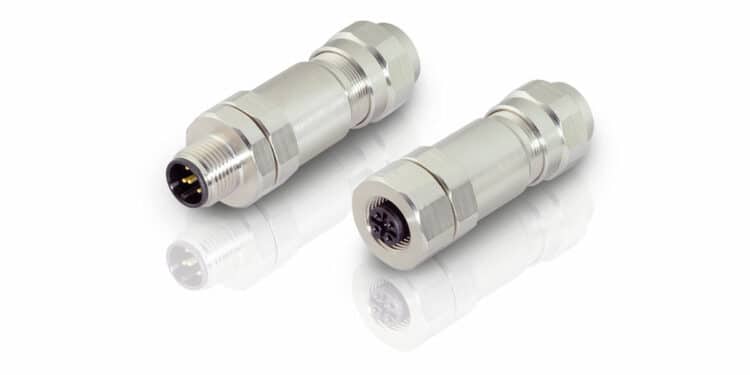binder, a leading supplier of industrial circular connectors, offers M5, M8, and M12 products for sensor cabling that feature threaded locking rings – and other design parts – made of stainless steel to protect against corrosion impact.
Sensor technology in the process industry is often exposed to humid, aggressive environments. In industries such as food or pharmaceuticals production, but also in medical applications, it is therefore often necessary to protect certain components against corrosion. Circular connectors in stainless-steel design can withstand humidity, chemicals, and cleaning agents. For data transmission, shieldable products whose outer parts are all made of stainless steel are recommended.
Unlike conventional connectors, with nickel-plated locking rings and housing parts made of die-cast zinc or brass, they are suitable for use under conditions that explicitly require media resistance. Connectors in stainless-steel design withstand corrosive environmental influences, such as contact with chemicals or aggressive detergents.
Applications with potential for corrosion
The term stainless steel is used as a generic term for corrosion-resistant chromium-nickel or chromium-nickel-molybdenum steels. They are used in machine engineering for components that have to be resistant to water and steam, food acids, and weak organic or inorganic acids. Their typical applications can be divided into two categories:
- on the one hand, applications in generally demanding environments where the components are exposed to humidity and may come into contact with aggressive media,
- on the other hand, applications that are subject to regular cleaning processes with corrosive agents.
Examples can be found in the food, pharmaceuticals, and cosmetics industries, for example in sensors for level or flow metering. Also, stainless-steel connectors are used in hygienically demanding medical environments.
In order to meet the high-level hygienic requirements of these applications, manufacturers such as binder adopt particular design details. For example, no or only a few undercuts are permitted to prevent contaminants from accumulating there. In addition, smooth surfaces and a hexagon instead of the usual knurled contour are advantageous.
Numerous types of binder’s M5, M8, and M12 designs are available as stainless-steel variants: in the M12 segment, for example, the 713/763 and 715/766 product series with panel mount connectors and overmolded cable parts as well as wireable connectors.
Stainless-steel variants on the example of M12
M12 panel mount connectors are available as stainless-steel versions as either male or female parts, which can be screwed onto the front or rear, with different pin counts, and both with or without wires. These connectors are available with A, B and D coding. As a special feature, binder also offers panel mount connectors with protective caps.
Overmolded cable parts are also available with stainless-steel threaded locking rings – instead of zinc die-cast. In these cases, the respective locking ring features a hexagon contour allowing the M12 thread of the connector to be easily attached and the torque to be applied. The stainless-steel locking rings are available for both male and female parts, in straight and angled designs. To provide connectors in the food and beverage industry with the mandatory protection against detergents, appropriately resistant plastics are used for their cables and overmoldings.
Wireable connectors are, on the one hand, designed as unshielded plastic components, with locking rings made of stainless steel instead of zinc die-cast. Since most connector elements are made of resistant plastic, it is sufficient to use the stainless-steel locking ring to achieve high media resistance. Here, male and female cable connectors are available in A-coding: 4-, 5-, and 8-pin, straight and angled, as well as duo versions. On the other hand, binder has a variant completely made of stainless steel in its portfolio.
M12 all stainless steel
In this M12 segment speciality, not only the threaded locking ring is made of stainless steel, but also the housing and pressing screw – and thus all external parts. This M12 overall metal version also allows for electromagnetic shielding and is thus suitable for transmitting high-frequency data.
In addition to the individual parts made of stainless steel, the cable clamp and its seal are also made of resistant materials here, namely the clamping element made of PTFE and the seal made of Viton. Thus, these connectors are very resistant to aggressive, corrosive environmental conditions. As a design detail that facilitates cleaning, they are almost entirely equipped with rounded surfaces.
This M12 stainless-steel version is available as male and female cable connectors, A-, B-, and D-coded, and with pin counts of 4, 5, 8, and 12. Only straight versions with a cable outlet between 3.0 and 8.6 mm are offered.






